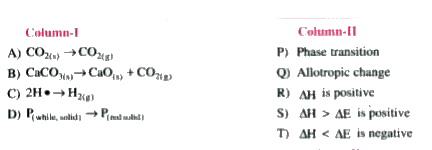The bond dissociation energy depends upon the nature of the bond and nature of the molecule. If any molecule more than 1 bonds of similar nature are present then the bond energy reported is the average bond energy.
Determine C−CandC−H bond enthalpy (in kJ/mol). Given: ΔfH0(C2H6,g)=−85kJ/mol,ΔfH0(C3H8,g)=−104kJ/mo≤,ΔsubH0(C,s)=718kJ/mol, B.E. (H-H)= 436 kJ/mol, Solution in Telugu
414345
345414
287405.5
none of these
The correct Answer is:B
The given reactions are 2C(graphite)+3H2(g)→C2H6(g),ΔH=−85kJ/mole …(1)
3C(graphite)+4H2(g)→C3H8(g),ΔH=−104 kJ/mole …(2)
C(graphite)→C(g),ΔH=718 kJ/mole …(3)
H2→2H,ΔH=436 kJ/mole ...(4)
To get expression for heat of reaction in terms of Bond energy we have to use the expression with all the components are in gaseous state. So, from Eq. (1) and (3)
2C(g)+3H2(g)→C2H6(g),ΔH=−1521kJ ...(5)
From Eq.(2) and (3)
3C(g)+4H2(g)→C3H8(g),ΔH=−2258kJ ...(6)
We know that heat of reaction Σ B.E of reactants =Σ B.E of products. So,
−1521=3(H−H)−[6C−H+C−C] ...(7)
−2258=4(H−H)−[8C−H+2C−C] ..(8)
On solving the above two equations. C- H bond energy = 414
C- C bond energy = 345
Topper's Solved these Questions
- CHEMICAL THERMODYNAMICSBOOK - AAKASH SERIESCHAPTER - CHEMICAL THERMODYNAMICSEXERCISE - PRACTICE SHEET (EXERCISE- II) (LEVEL- II (ADVANCED) MATRIX MATCHING TYPE QUESTIONS)
2 Videos
- CHEMICAL THERMODYNAMICSBOOK - AAKASH SERIESCHAPTER - CHEMICAL THERMODYNAMICSEXERCISE - PRACTICE SHEET (EXERCISE- II) (LEVEL- II (ADVANCED) INTEGER TYPE QUESTIONS)
6 Videos
- CHEMICAL THERMODYNAMICSBOOK - AAKASH SERIESCHAPTER - CHEMICAL THERMODYNAMICSEXERCISE - PRACTICE SHEET (EXERCISE- II) (LEVEL- II (ADVANCED) MORE THAN ONCE CORRECT ANSWER TYPE QUESTIONS)
6 Videos
- CHEMICAL THERMODYANMICS BOOK - AAKASH SERIESCHAPTER - CHEMICAL THERMODYANMICS EXERCISE - Questions For Descriptive Answers
28 Videos
- ELECTRON MIGRATION EFFECTS BOOK - AAKASH SERIESCHAPTER - ELECTRON MIGRATION EFFECTS EXERCISE - QUESTIONS FOR DESCRIPTIVE ANSWERS
10 Videos
Similar Questions
Match the following columns

View SolutionFor the reaction, N2(g)+3H2(g)→2NH3(g). Heat of reaction at constant volume exceeds the heat of reaction at constant pressure by the value of xRT. The value of x is______
View SolutionThe value of ΔH−ΔU for the following reaction at 27∘C will be : N2(g)+3H2(g)→2NH3(g)
View SolutionHow does heat of neutralisation value change with the chemical nature of acid and base?
View SolutionHyperconjugation effect is also termed as 'no bond resonance'. Why?
View SolutionUsing the bond enthalpy data given below, calculate the enthalpy of formation of acetone (g). Bond enegry C-H = 413.4 kJ mol^(-1) , Bond enegry C-C = 347.0 kJ mol^(-1) , Bond enegry C=O = 728.0 kJ mol^(-1) , Bond enegry O=O = 495.0 kJ mol^(-1) , Bond enegry H-H = 435.8 kJ mol^(-1) , Delta_("sub")H^(Theta)C(s) = 718.4 kJ mol^(-1)
View SolutionIf Delta_(f)H^(@) _(C_(3)H_(8)(g))=-85kJ moll^(-1), Delta_(f)H^(@) _(C_(3)H_(8)(g))=-104kJ mol^(-1), DeltaH for C_((s))rarr C_((g)) is 718kJ mol^(-1) and heat of formation of H- atom is 218kJ mol^(-1) , then :
View SolutionGiven the bond energies of H−H and Cl−Cl are 430kJmol−1 and 240kJmol−1, respectively, and ΔfH∘ for HCl is −90kJmol−1. Bond enthalpy of HCl is
View SolutionDetermine C-C and C-H bond enthalpy (in kJ//mol ) Given : Delta_(f)H^(@)(C_(2)H_(6),g)=-85kJ//mol," "Delta_(f)H^(@)(C_(3)H_(8),g)=-104kJ//mol Delta_("sub")H^(@)(C,s)=718kJ//mol," "B.E.(H-H)=436kJ//mol
View SolutionCalculate resonance energy of C6H6(g).
Given :Δf[C6H6(g)]=−360kJmol−1ΔHSub[C(graphite)]=716kJmol−1B.E.H−H=437kJmol−1B.E.C=C=620kJmol−1B.E.C−C=340kJmol−1B.E.C−H=490kJmol−1
View SolutionGiven the bond energies of H−H and Cl−Cl are 430kJmol−1 and 240kJmol−1, respectively, and ΔfH∘ for HCl is −90kJmol−1. Bond enthalpy of HCl is
View SolutionCalculate the enthalpy change for the process
CCl4(g)→C(g)+4Cl(g)
and calculate bond enthalpy of C−Cl in CCl4(g).
ΔvapHΘ(CCl4)=30.5kJmol−1
ΔfHΘ(CCl4)=−135.5kJmol−1
ΔaHΘ(C)=715.0kJmol−1, where ΔaHΘ is enthalpy of atomisation
ΔaHΘ(Cl2)=242kJmol−1
View SolutionUsing the data provided, calculate the multiple bond energy (kJ mol−1 ) of a C≡C bond in C2H2 . That energy is (take the bond energy of a C- H bond as 350 kJ mol−1)
2C(s)+H2(g)→C2H2(g)ΔH=225kJmol−1
2C(s)→2C(g) ΔH=1410kJmol−1
H2(g)→2H(g) ΔH=330kJmol−1
View SolutionIf the bond energy of C-H bond is +416.18 kJ⋅mol−1, then what will be the enthalpy of formation of C-H bond?
View SolutionCalculate Delta_(r)H^(@) for the reaction, H_(2)(g) + 1/2O_(2)(g) to H_(2)O(g) Given that bond enthalpies of H-H bond , O = O bond and O - H bond are 433 kJ mol^(-1) , 492 kJ "mol"^(-1) and 464 kJ "mol"^(-1)
View SolutionGiven that the bond energies of H - H and CI - CI are 430 kJ "mol"^(-1) and 240 kJ "mol"^(-1) respectively and Delta_(f)H for HCI is -90 kJ "mol"^(-1) , bond enthalpy of HCI is
View Solution
